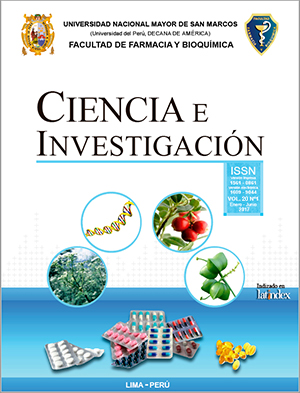Bromophenolic compounds and antioxidant activity of red algae extracts Polysiphonia paniculata Montagne
DOI:
https://doi.org/10.15381/ci.v20i1.14315Keywords:
Rodophyta, Polysiphonia, bromophenol, antioxidant activity, DPPH, IR spectrumAbstract
The present study had as objetives to identify the presence of phenolic compounds, as well as to evaluate and compare the in vitro antioxidant activity of the ethereal, dichloromethane and ethanolic extracts obtained from the algae Polysiphonia paniculata Montagne, using the DPPH method (1,1-diphenyl-β -picrilhydrazyl), radical scavening method. Several species of the genus Polysiphonia, from the family Rhodomelaceae, have been reported to present bromophenolic compounds with antioxidant activity. Phytochemical screening results revealed the presence of phenolic compounds according to the thin layer chromatographic profile and the IR spectrum in ethereal (very slightly) and dichloromethane extracts. The results of the DPPH method revealed that the dichloromethane extract had higher antioxidant activity compared to ethereal and ethanolic extracts. The following percentages of antioxidant capacity were obtained (at 400μg/mL): Dichloromethane extract = 74%, ethereal extract = 35.1% and ethanolic extract = 22.3%, compared to Vitamin C, which presented a percentage of antioxidant activity of 83.0% (2.4g μg/mL). The Infrared spectrum of the dichloromethane extract exhibited an absorption band for hydroxyl groups at 3327 cm-1 and absorption bands for aromatic groups at 1546 cm-1 and 1463 cm-1 and Bromine at 719 cm-1.
It is concluded that the dichloromethane extract has higher antioxidant activity attributed to the presence of low polar phenolic compounds.
Downloads
Published
Issue
Section
License
Copyright (c) 2018 Belén González, Cesar Fuertes, Carlos Yauri, Kurwoll Vega

This work is licensed under a Creative Commons Attribution-NonCommercial-ShareAlike 4.0 International License.
LOS AUTORES RETIENEN SUS DERECHOS:
- Los autores retienen sus derechos de marca y patente, y tambien sobre cualquier proceso o procedimiento descrito en el artículo.
- Los autores retienen el derecho de compartir, copiar, distribuir, ejecutar y comunicar públicamente el articulo publicado en la Revista Ciencia e Investigación (por ejemplo, colocarlo en un repositorio institucional o publicarlo en un libro), con un reconocimiento de su publicación inicial en la Revista Ciencia e Investigación.
- Los autores retienen el derecho a hacer una posterior publicación de su trabajo, de utilizar el artículo o cualquier parte de aquel (por ejemplo: una compilación de sus trabajos, notas para conferencias, tesis, o para un libro), siempre que indiquen la fuente de publicación (autores del trabajo, revista, volumen, numero y fecha).













